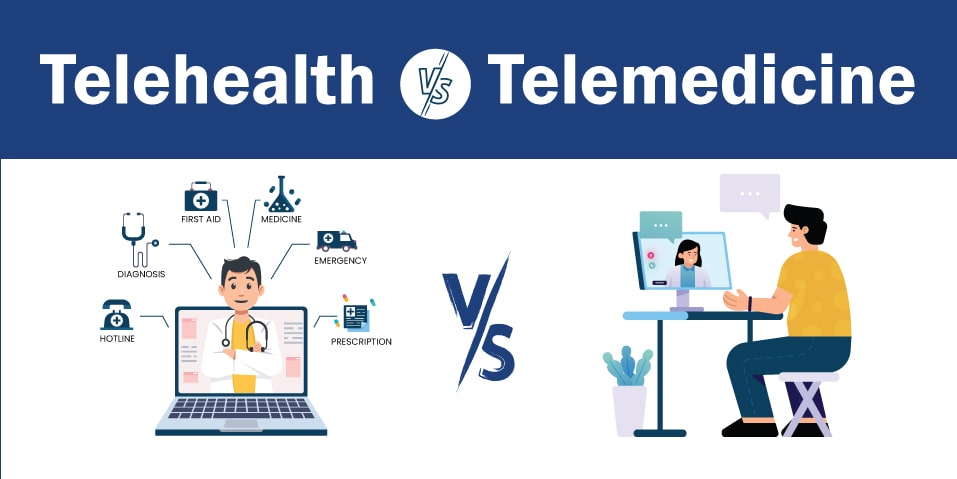The terms Telemedicine and Telehealth sound the same, but a definite distinction between them. However, if you want to get technical, Telemedicine is really a subset of Telehealth. Let’s know the Difference between Telehealth and Telemedicine. This article will assist you to understand Telehealth vs Telemedicine in detail.
HealthIT.gov defines Telehealth as “the use of electronic information and telecommunication technologies to help and facilitate long-distance healthcare care, patient and skilled health education, and public health and health administration. “Telehealth is no service. This is a way to improve medical care and doctors in healthcare. Telehealth extends beyond telemedicine, to cover non-clinical activities like arranging an appointment, continuing medical education, and physical training.
Telemedicine is described by the World Health Organization (WHO) as “healing from a distance.” This allows you the right to seek care without having to make an appointment with your physician or go to their medical office.
Table of Contents
ToggleDifference Between Telehealth and Telemedicine
The terms telehealth and telemedicine are sometimes mixed up, but they each have their unique characteristics. It’s crucial for healthcare providers to distinguish between them when aiming to enhance patient care. Here, we’ll break down the difference between telehealth and telemedicine in simple terms.
What is Telehealth?
Telehealth is all about providing care and services from afar using technology. It includes a range of remote healthcare services like telemedicine, remote monitoring, medical training, prescription delivery, and more.
Telehealth solutions not only offer convenience but can also lead to significant cost savings per visit, making healthcare more accessible and affordable.
What is Telemedicine?
Telemedicine falls under the telehealth umbrella and focuses on remote clinical healthcare services. It provides medical care to patients from a distance, eliminating the need for in-person visits. It is particularly handy for follow-up appointments, chronic care, and consultation with specialists via video calls.
Notably, telemedicine has significantly reduced emergency room visits and hospitalizations. Moreover. it has also expanded healthcare access for approximately 20% of Americans in rural areas.
Read More: The Complete Guide of Telemedicine
Telehealth vs Telemedicine
This table will clear your doubt regarding the Telehealth vs Telemedicine.
| Telehealth | Telemedicine |
| In addition to providing only medical treatment, Telehealth provides a broader spectrum of health care facilities at a distance. It consists of all stakeholders in healthcare, such as doctors, care teams, nurses, technicians, or pharmacists. To help healthcare management, literature, and access to medical information, it utilizes various telecommunication technologies. Examples of telehealth are health education, ECG, virtual medical appointments, patient care, handling clinical workflows. | Telemedicine focuses only on providing distance learning and medical care, diagnosis, and treatment-related services. It is treatment-centric and restricted only to care for delivery. To provide medical services, it utilizes telecommunication technology. Examples of telemedicine are carrying diagnostic tests, tracking the progress of patients during treatment, and video consultations with specialists. |
| Telehealth is a customer-facing technique that applies to a broad range of remote healthcare facilities, such as a wide range of diagnosis and management, education, and other associated healthcare sectors. | Telemedicine is a sub-set of Telehealth and is known to be the clinical application of technology that uses medical practice to deliver remote treatment through technology. |
| The more popular telehealth can be used in general health care services. | Although telemedicine specifically deals with a clinician delivering a very different form of health care. |
| Many different forms of diagnosis, management, and education are encompasses in Telehealth. | Telemedicine refers to traditional technology-provided clinical diagnosis and screening. |
| Healthcare education, remote partnerships between medical professionals, and the technology themselves, such as monitoring devices and software, are also included in Telehealth. | Consultations between providers and the digital transmission of medical records and diagnostic images can also include telemedicine. |
| The worldwide telehealth market is expected to rise to US$ 26.7 billion by 2025 at a CAGR of 28.6 percent. Due to expanded services and business expansion in these countries, North America and Europe are expected to dominate the worldwide telehealth market during the forecast era. | At a CAGR of 15.3 percent, the global telemedicine market is projected to expand to reach US$ 52.3 billion by 2022. Some of the factors driving the demand for telemedicine solutions are increasing chronic disease prevalence, increasing numbers of people linked to the internet, and aging populations across different geographies. |
| Telehealth is similar to telemedicine, but outside the doctor-patient relationship, it provides a broader spectrum of remote healthcare facilities. It also includes services given to patients and their caregivers by nurses, pharmacists, or social workers, for example, who assist with patient health education, social support and adherence to medication, and troubleshooting health problems. | Telemedicine can be characterized as the use of telecommunications technology to facilitate the provision by physicians of all forms of medical, diagnostic, and treatment-related services. This involves, for instance, carrying out medical tests, closely tracking the progress of a patient during medication or therapy, and promoting access to experts that are not in the same position as the patient. |
| The communication and tracking services of Telehealth are excellent for empowering patients with the potential to take a more involved and independent role in the management of chronic illnesses and careful monitoring. | Telemedicine technology, such as web-based meeting management software and a suite of high-tech clinical equipment and telemedicine carts, on the other side of the spectrum, provide physicians with a means of extending the effective reach of their coverage. |
| Examples of Telehealth A Consultation and Education Video Conferencing Network A health app that warns individuals of an imminent outbreak Fit Bits that measure your heart rate and pulse | Example of Telemedicine An app that lets doctors remotely treat their patients via video conferencing Software that allows patients to send pictures to their doctors of a rash or a mole that has disturbed them. An app that schedules doctors’ appointments within minutes. |
How Does Telehealth Work?
Telehealth services ensure that doctors stay connected to the patients and our patients stay connected to doctors no matter where they are.
By using the telehealth service, our movement disorder and Parkinson’s disease specialists can provide you with quick, convenient, remote access to consultations, treatment, and advice ensuring that you get the care that you need, without disrupting your daily routine. For some patients with a movement disorder, mobility can be difficult, and telehealth services become vital to the ongoing treatment and monitoring of progressing conditions.
Live video streaming and video conferencing allow the patients and neurology specialists to communicate directly through a live video call. This method of communication acts as a substitute for an in-office meeting when one cannot be made. It allows doctors to identify, diagnose, and monitor the visible signs of movement disorders, such as tremors. This is also facilitated primary care and specialist care referral services by allowing several doctors in different-different locations to collaborate on diagnoses and determine the best treatment and care options available not only in one area but worldwide.
Mobile health (mHealth) allows patients and motion disorder specialists to deliver healthcare and educational support through mobile devices such as telephones and tablet computers. Communication can be conducted by text messaging, speaking over the phone, instant messaging, or online communication platforms such as chat rooms. Mobile health provides a method for constant mobile communication so that no matter where you are, we are always just a phone call away.
Remote Patient Monitoring System (RPMS) uses remote technology to allow neurology specialists to monitor the progress and care by sharing information directly with them. MDPDS provides remote devices that can record information such as your weight, blood pressure, and heart rate, for example, and relay this information directly to your dedicated MDPD specialist. This type of in-home monitoring is useful because it allows your movement disorder specialist to continuously monitor any changes in your condition and potentially identify problems before they start to show physical signs. Reminders built into these devices also help to ensure you stick to a routine and don’t forget to do what is needed.
Store and forward techniques allow the sharing of historical, educational resources and information through mediums such as pre-recorded videos or digital images such as x-rays or photographs. This methodology empowers patients by providing them with an alternate source of communication. By simply recording a video using your mobile phone video camera, and sending it to your neurology specialist via email, MMS, or text message you can relay information about symptoms that may be causing you concern.
Historical store and forward techniques also enable specialists to evaluate and share data with other medical professionals. This data can collectively provide a more thorough overview of symptoms for diagnoses and facilitate the design of tailored treatment and care programs that may be available outside of your existing network.
Read More: What Are The Advantages Of Telemedicine App In Healthcare Industry?
How Does Telemedicine Work?
Well, the difference table cleared your mind to understand Telehealth vs Telemedicine. Now we’ll discuss how telemedicine works? How telemedicine works are simple. Telemedicine is the use of technology that enables remote healthcare. It makes it possible for physicians to treat patients whenever needed and wherever the patient is, by using a computer or smartphone.
Telemedicine isn’t appropriate for emergencies like a heart attack or stroke, cuts or lacerations, or broken bones that require x-rays, splints, or casts. Anything that requires immediate, hands-on care should be handled in person. However, telemedicine app development plays a vital role in providing solutions for simple issues and follow-up consultations.
For instance, if you suspect that a cat may be infected, you can schedule a virtual consultation with your healthcare provider to discuss your symptoms. If you’re on vacation and think you’re coming down with strep throat, you can communicate with your primary care physician. If you need a birth control medication, you can chat through your needs and get a same-day prescription.
It’s helpful for a variety of other health issues including psychotherapy and teledermatology, which offers consultations of moles, rashes, etc. Colds and flu, insect bites, sore throats, diarrhea, and pink eye are some other common issues addressed using telemedicine.
Have An Idea for Telemedicine?
We Build Plenty of Telemedicine! Get The FREE Estimation of Your Product Idea.
Who Uses It?
If your doctor provides the option, the secure internet, and a desktop, laptop or computers are all you need to use telemedicine.
Telemedicine is a convenient resource for all but it is especially helpful if you:
- Live in a rural area or doctor’s office is not nearby your area
- Have limited movement, time, or transportation
- Need medical care when you are not at home or far away from home
Conclusion
DreamSoft4U, a Healthcare IT Services Provider in India Offers HIPAA-compliant healthcare software solutions including interfacing EMR/EHR systems with different software such as Health Information Exchanges, Digital Imaging and Communications in Medicine (DICOM), and Picture Archiving and Communication Systems (PACS), and Remote Practice Management Systems (RPMS). We program modules for e-prescribing (e-Rx), E/M coding, and billing, as well as scheduling procedures and lab services.
Services include:
• HL7 Solutions
• HIPAA Compliant Solutions
• Health Information Exchange
• Medical Billing Solutions
• Patient Care Management
• Patient Appointment Scheduler
• Patient engagement apps
• Remote Health Monitoring System
• Electronic Health & Medical Records (EHR, EMR)
• Mobile app development (iOS and Android)
FAQs
Q1. Which Telehealth platform is right for me?
Choosing the right Telehealth platform is vital. Look for features like scheduling, billing, and patient record integration. Ensure security with HIPAA compliance and strong encryption, and prioritize scalability for future patient volumes.
Q2. How do I ensure data privacy and security in Telehealth?
Follow these steps:
- Choose platforms compliant with HIPAA, ensuring end-to-end encryption.
- Implement access controls and conduct regular security audits.
- Educate patients on data privacy and obtain informed consent.
Q3. What are the costs of implementing Telehealth?
Costs differ between providers and can be monthly or annually—additionally, factor in hardware, IT infrastructure, staff training, and ongoing maintenance and support costs.
Q4. How can I integrate Telehealth into my existing branding?
The answer is “white-label telemedicine platform”. It can be customized with your brand and logo, fitting smoothly into your existing branding.
Q5. What are the maintenance requirements for Telehealth?
The requirements include:
- Regular software updates and security patches.
- Backup and recovery plans for emergencies.
- User support for technical issues and ongoing staff training.
Q6. How can I measure the success of Telehealth services?
Monitor patient adoption, satisfaction, and provider efficiency. Keep an eye on revenue generation, reduced wait times, and enhanced access to care.





















